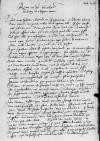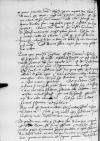Pestis anni praeteriti ab aula me segregaverat et libenter aberam, nam interea temporis rebus meis operam dedi et haec causa erat silentii mei. Nunc ⌊⌋ Reverendissimae Dominationis Vestrae ad intermissum scribendi officium redeo, sit modo aliquid, quod illam iuvare possit, sed praeter illa pervulgatissima et iam diu nota Vestrae Reverendissimae Dominationi de morte ⌊regis patris⌋, de adventu ⌊huc⌋ ⌊regis filii⌋, de matrimonio illius, nulla alia sunt, quae scribi Dominationi Vestrae possint.
⌊Regis⌋ sepultura instituta est 1548-07-26⌊postridie sancti Iacobi1548-07-26⌋, quae, uti adornatur, futura est cum magno apparatu et magna pompa. Qua absoluta ⌊rex⌋ ibit ⌊Pyotrkoviam⌋ ad ⌊comitia magna Regni⌋ ad 1548-08-10⌊diem sancti Laurentii1548-08-10⌋ instituta. Audio tamen a multis, quod multi domini consiliarii cupiunt eadem ⌊comitia⌋ ad 1548-09-08⌊diem Natalis Sanctae Mariae1548-09-08⌋ vel ad maximum ad 1548-08-24⌊diem sancti Bartolomei1548-08-24⌋ differri, ut commode et sepulturae, et comitiis possent interesse et rei domesticae tempore hoc messis operam dare. Sed plerique opinantur non rem familiarem esse in causa, sed ut spatium habeant productius ad instruendum ea, quae practicari debebunt in ipsis ⌊comitiis⌋. Sed tamen, ut practicae istae factiosorum mitigentur, audio, quod offa loquacibus istis in os obtruditur, ut canes isti taceant. Subornantur, ut matrimonium hoc, si non probaverint, {ut} silentio praetermittant. Populus fortasse non tacebit, optimates tacebunt. Sed de futuris non facile est divinare.
Inter ⌊matrem⌋ et ⌊filium regem⌋, tametsi privatim fortasse non bene conveniat, nam mater factum filii non probat, publice tamen offensiones nullae palam sunt. ⌊Mater⌋ etiam frustra se opponeret, nam non oboediretur ei. Et idcirco ⌊mater⌋ decrevit omnino ⌊hinc⌋ mox post sepulturam abire ad ⌊Varssoviam⌋ ad perpetuam commorationem. Non vult aspicere dominam ⌊Barbaram⌋, quae ⌊huc⌋ brevi post adduci debet. ⌊Reginulae⌋ etiam ⌊matrem⌋ obsecrant, ut eas secum mater accipiat. Alioqui, si penes dominam ⌊Barbaram⌋ relinqui deberent, malunt monachismum suscipere aut ad hospitalia mendicorum concedere. De ⌊quarum⌋ tamen nuptiis nihil scio. Hoc video, quod ⌊rex⌋ argentum, scutellas, cupas, vasa, vestes pretiosas, mundum muliebrem ⌊eis⌋ adornari facit et parat sororibus omnia, tamquam si proxime maritis dari debeant. Ut tamen ego conicio, cuperet ⌊eas⌋ quamprimum extrudere et ⌊matrem⌋ non retinet, ut ⌊hic⌋ secum maneat. Vult omnino solus esse cum domina ⌊Barbara⌋ sua neque habere supra se custodes seu reprehensores. ⌊Domina nostra⌋ decrevit ⌊hic⌋ cum ⌊filio⌋ non manere. De ⌊filiarum⌋ matrimoniis nihil plane scimus, sed hoc scio, quod ⌊mater⌋ vellet eas elocare. Credoque, quod ut est ⌊domina⌋ pecuniosa, aliquid de suo in dotem ⌊eis⌋ dabit, si non vivens, certe post mortem. Sed dominus ⌊filius⌋ nescit ⌊hanc ovem⌋ plenam lacte mulgere.
Penes ⌊regem⌋ pauci sunt consiliarii. Est ⌊episcopus Camenecensis⌋, ⌊Chelmensis⌋, est ⌊zupparius⌋, est ⌊Ociesski⌋ castellanus Biecensis, qui post mortem domini ⌊Volski⌋ factus est magister curiae ⌊reginalis maiestatis⌋, est dominus ⌊Grabia⌋ vicecancel[larius], sed hi sunt veluti quinta ac supernumeraria rota quadrigae. ⌊Episcopus Cracoviensis⌋ et ⌊castellanus Cracoviensis⌋ sunt penes ⌊regem⌋. ⌊Hi⌋ duo princip[atum] obtinent et gratiam ⌊regis⌋. Contra ⌊quos⌋ tamen ubique clamatur inimicissime. Dira nescio quae ⌊his⌋ denuntiantur, quae in comitiis vel in castris maxime apparebunt. Dominus ⌊palatinus Cracoviensis⌋ existimans se non habere gratiam ⌊domini⌋ discessit ⌊hinc⌋ ad ⌊Vissnicze⌋ et, ut ex eius intimo subodoravi, fabricantur illic ad futura ⌊comitia⌋ consilia. Eiusmodi fortasse, quae nos omnes fortasse perturbabunt, nisi Deus al
<i>
ter ordinarit. Sed haec omnia meliores, quam homines suspicantur, exitus habebunt.
⌊Rex⌋ vult esse severus in iudiciis, contra homicidas praesertim, raptores, violatores etc. Credo, quod non malum ⌊regem⌋ habebimus, si modo ⌊consiliarii⌋ mali consilia eius bona non pervertant.
De ⌊Prussia⌋ vero nobis per ⌊Cruciferos⌋ istos de laeva cruce eripienda Dominatio Vestra Reverendissima se non afflictet. Antequam hoc fieret, multus prius Germanicus sanguis fundetur in agris Polonicis. Non deerunt nobis nec viri, nec equi, nec arma, nec opes, nec auxilia tanta, quanta nec ⌊Germania⌋ tota superare poterit. Nobiscum Deus, erit adiutor noster, qui blasphematores ⌊istos⌋ confundet. Dominatio Vestra Reverendissima bene omnia speret. Deus nos non deseret sperantes in se.
Mitto Reverendissimae Dominationi Vestrae orationem adversus matrimonium ⌊regis⌋ nostri scriptum. Mitto et Pasquillum. Dicuntur et scribuntur haec, ut fit, inter homines non ineruditos, sed tempore, uti alia omnia, sic haec vanescent et erunt omnia meliora.
Me Vestrae Reverendissimae Dominationi commendo et valere illam felicissime desidero.



